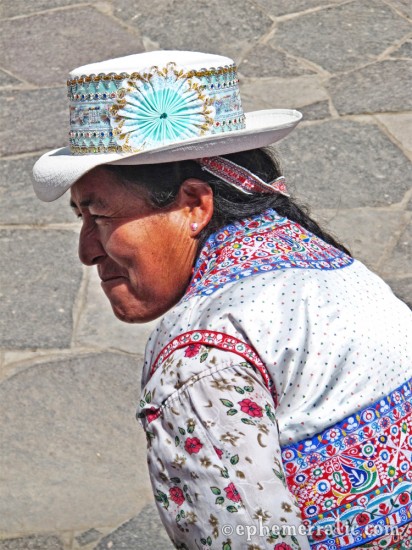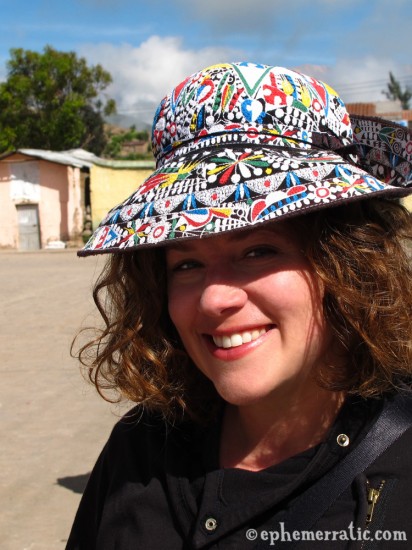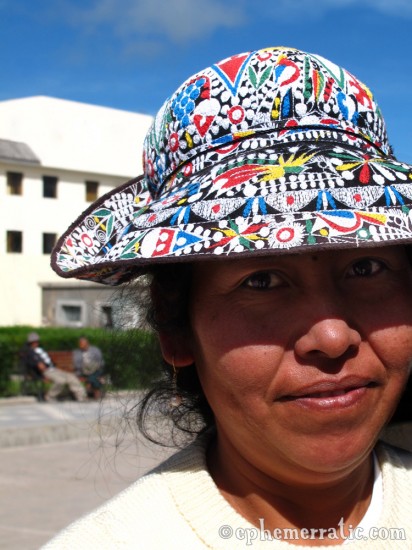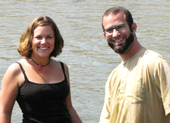Haberdashery: Better than head-smashery
Back in Pre-Hispanic times, two ethnic groups in the Colca Canyon area of Peru deformed their babies’ skulls — the Collagua into a taller, tapered noggin, the Cabana into a mesa-shaped cranium.
Was the Collagua’s headscaping a disturbed bid for a permanent Bumpit? Was the Cabana’s reshaping a misguided effort to gain a competitive edge in breakdance headspinning? Or were these groups just looking for a way to easily spot friends in a crowd, like those older tourist couples who wear matching outfits?
It really doesn’t matter. There isn’t a good reason* for squashing a baby’s head.
Ultimately, someone came to their senses — probably the first parents who were no-shows to the Infant Cranial Deformation Jamboree — and realized that a distinctive hat would give ease of recognition without extreme body modification.
Today, women of Collagua descent wear flat-brimmed straw hats circled with a colorful, bejazzled band. Cabana women wear rounded hats, brim flipped up in the back, covered with embroidery inside and out.
I’ve been admiring both hat styles during our time in Colca Canyon, impressed by the craft, time, and tough calluses that must go into making them. I’m also a fan of practical things imbued with bespoke flair, like handmade Halloween costumes, personalized beer cozies, and fashionista hoodies. I’m curious about how the hats are made and also the meaning of the symbols that adorn them.
While waiting for the bus that would take Todd and me out of Cabanaconde to Arequipa, I noticed a behatted Peruvian woman loitering alone in the plaza. Dragging Todd along as translator, I tell him to tell her I like her hat, ask her if she made it, and how long it took to create.
“En un día,” she responds politely but shyly, as if the results are no big deal. All the while she glances around the plaza for someone to rescue her from my chatter.
All that elaborate work, done in one day. Her hat looks new, which makes me want know how many hats she has. I wonder if she used the same design as her mother does, or if it’s uniquely her own. As I start telling Todd my next question, she takes off her hat and hands it to me, then wordlessly points to my camera.
“I think she thinks I want a picture of myself wearing her hat,” I say to Todd. “What should I do? Is it weird? It seems weird.”
“Give me the camera,” he insists.
“Mi cabeza,” I laugh as I try to squash the hat on my head, “es grande!” That much Spanish I know.
She won’t join me in the photo, brushing her hand over the top of her hair as if to indicate: “Not with my hair looking like this.”
Our bus driver revs the engine, honks the horn, and starts shouting. Todd says, “Babe, we gotta go.”
I reluctantly, jealously return the hat.
__
* Here is one historical account of the reasons why the Collagua and Cabana shaped their heads (or if you prefer happier thoughts, skip over to a photo essay of Peruvian wildflowers):
“[In 1586, Juan de] Ulloa Mogollón [a Spanish official] left a record of a strange, yet intriguing form of mountain worship that involved transforming humans into representations of peaks. The Collagua…believed their paqariku (place of origin) was a snow-capped volcano called Collaguata…to honor it, they bound the malleable heads of their newborn children to make them tall, thin, and slightly tapering, in imitation of the peak’s shape…”
“The residents of [Cabana] province…thought they originated from the summit Gualcagualca, which they considered holy. As an expression of their devotion, they wrapped white cords around the heads of their babies, circling the crown numerous times. This procedure caused the skulls to flatten out on top and become very wide, mimicking the outline of Gualcagualca.”
– Of Summits and Sacrifice: An Ethnohistoric Study of Inka Religious Practices, Thomas Besom, University of Texas Press, 2009.





love this! thanks for the great post and photos.
Thanks Cynthia!
just came across your blog and am enjoying it since i was in peru last march/april and in much of the same territory as you. find it particularly interesting since, though im much older than you, we seem to have very similar travel interests – adventure, new culture, language, people watching, food, photography. your thoughts about and photos of the colca canyon area made smile since you seem to have been as fascinated by the hats of that area as i was. inspired me to go back and look at my hat photos from there :)…..and made me miss peru greatly :(
assume youve left the area but if not the thermal baths in chivay make for a great afternoon.
wondering if youre heading north. my biggest regret is that i didnt make it northern peru since from everything i know it is wondrously beautiful and largely untainted by the excesses of the tourist industry?
dale
I was actually in Peru back in March 2012 too. I just had so much to share, and found so much that was awe-inspiring and unexpected in Peru it’s taken me that long to share it all!
I didn’t make it north, sadly. But, I am already scheming of a way to return to Peru, knowing how much there is to see and do there that I missed. The northern beaches, the Amazon, many mountain and volcano treks…it’s an amazingly rich country!
Wow, the head shaping tradition is fascinating, if a bit grotesque! And I had been curious about the different hats that the different cultures wore. Those little details were something I regret not learning more about in our short time in Peru. One more reason I’m glad I found your blog. Thanks for helping me fill in the gaps :)
I know, I couldn’t really believe it when I first read about it, figuring it was some weird internet rumor. But, after digging up a few reliable sources, it seemed legit enough to share.
I’m glad we’ve found each other’s blogs!